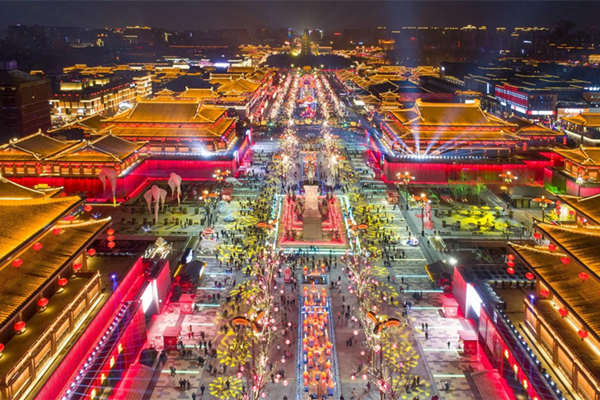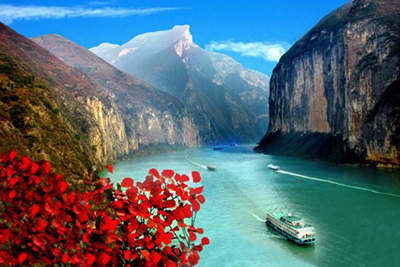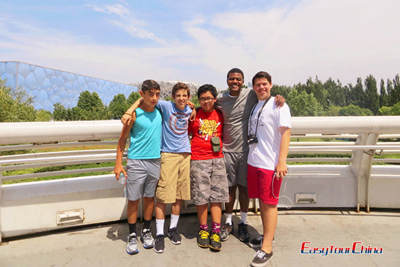Tang Dynasty (Empire Tang)
The Tang Dynasty (618-907) is the most glistening historic period in Chinese history. During this glorious period, the politics, economy, culture and military strength reached an unprecedented advanced level. Its capital, Chang'an (present-day Xi'an), the most populous city in the world at that time, became a cultural and international trade center.
Tang is a period that spread its culture and absorbed the cultures of surrounding states - a golden age of cosmopolitan culture. Buddhism, which had gradually been established in China from the first century, became the predominant religion and was adopted by the imperial family and many of the commoners.
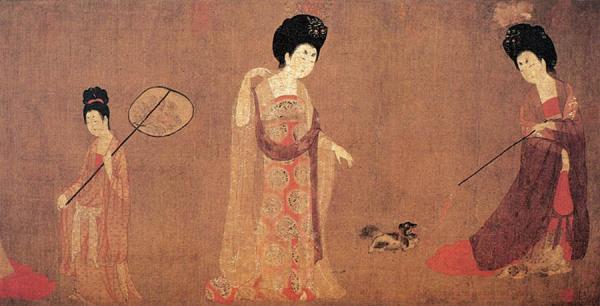
At that time, Chang'an, along with Luoyang and Guangzhou, and other trading centers, were all home to foreign communities. They brought with them new religions, food, music and traditions. A great part of Tang aristocracy even was of Non-Chinese origin, and merchants from Inner Asia dwelled Chang'an. Cultural relations were established with many countries include Japan, Korea, India, Persia and Arabia.
This period produced perhaps China's two most famous poets - Du Fu and Li Bai. There was another famous woman in Tang Dynasty - Wu Zetian. She was the only female emperor in Chinese history.
Tang Dynasty Facts
Tang Dynasty Emperors & Timeline with Years
There were 21 emperors ruled the Tang Dynasty, including those who were deposed. The first emperor of the Tang Dynasty was Li Yuan, Emperor Gaozu of Tang. The last emperor of the Tang Dynasty was Li Zhu, Emperor Jingzong of Tang, better known as Emperor Ai of Tang. The most important emperors of the Tang Dynasty are Emperor Gaozu, Emperor Taizong, and Emperor Xuanzong. Here is China’s Tang Dynasty emperors list in chronological order.
| Sovereign | Personal Name | Posthumous Name | Reign Years | Mausoleum | Remarks |
|---|---|---|---|---|---|
| Emperor Gaozu of Tang (唐高祖) | Li Yuan (李渊) | Emperor Shenyao (神堯皇帝)) | 618-626 | Xianling Mausoleum (献陵) | The founder and first emperor of the Tang Dynasty |
| Emperor Taizong of Tang (唐太宗) | Li Shimin (李世民) | Emperor Wenwu (文武皇帝) | 626-649 | Zhaoling Mausoleum (昭陵) | One of the greatest emperors in Chinese history |
| Emperor Gaozong of Tang (唐高宗) | Li Zhi (李治) | Emperor Tianhuang (天皇大帝) | 649-683 | Qianling Mausoleum (乾陵) | Assisted by Empress Wu for over half of his reign. |
| Emperor Zhongzong of Tang (唐中宗) | Li Xian (李显) | N/A | 684 | Dingling Mausoleum (定陵) | Deposed by Empress Wu |
| Emperor Ruizong of Tang (唐睿宗) | Li Dan (李旦) | N/A | 684 | Qialling Mausoleum (桥陵) | A puppet ruler controlled by Empress Wu |
Wu Zhou Dynasty (690-705): an interregnum of the Tang Dynasty | |||||
| Emperor Zhongzong of Tang (唐中宗) | Li Xian (李显) | Emperor Xiaohe (孝和皇帝) | 705-710 | Dingling Mausoleum (定陵) | He became emperor again after Empress Wu was deposed. |
| N/A | Li Chongmao (李重茂) | Emperor Shang (殇皇帝) | 710 | Unknown | The shortest reign in the Tang Dynasty (only 17 days) |
| Emperor Ruizong of Tang (唐睿宗) | Li Dan (李旦) | Emperor Xiaowen (孝文皇帝) | 710-712 | Qialling Mausoleum (桥陵) | |
| Emperor Xuanzongof Tang (唐玄宗) | Li Longji (李隆基) | Emperor Zhidao (至道皇帝) | 712-756 | Tailing Mausoleum (泰陵) | The Tang Dynasty reached its peak during his reign. |
| Emperor Suzong of Tang (唐肃宗) | Li Heng (李亨) | Emperor Wenming (文明皇帝) | 756-762 | Jianling Mausoleum (建陵) | The An Lushan Rebellion was suppressed. |
| Emperor Daizong of Tang (唐代宗) | Li Yu (李豫) | Emperor Ruiwen (睿文皇帝) | 762-779 | Yuanling Mausoleum (元陵) | The beginning of Fanzhen Geju (splittism of military settlements along the empire’s border areas) |
| Emperor Dezong of Tang (唐德宗) | Li Kuo (李适) | Emperor Shenwu (神武皇帝) | 779-805 | Chongling Mausoleum (崇陵) | Allied with Nanzhao and Huihe to defeat Tufan |
| Emperor Shunzong of Tang (唐顺宗) | Li Song (李诵) | Emperor Zhide (至德皇帝) | 805 | Fengling Mausoleum (丰陵) | |
| Emperor Xianzong of Tang (唐宪宗) | Li Chun (李纯) | Emperor Zhaowen (昭文皇帝) | 805-820 | Jingling Mausoleum (景陵) | The economy recovered gradually. Everything was flourishing again. |
| Emperor Muzong of Tang (唐穆宗) | Li Heng (李恒) | Emperor Ruisheng (睿圣皇帝) | 820-824 | Guangling Mausoleum (光陵) | He indulged himself in pleasure rather than performing his duties as emperor. |
| Emperor Jingzong of Tang (唐敬宗) | Li Zhan (李湛) | Emperor Ruiwu (睿武皇帝) | 824-827 | Zhuangling Mausoleum (庄陵) | He also indulged himself in pleasure. Eunuchs held onto real power. |
| Emperor Wenzong of Tang (唐文宗) | Li Ang (李昂) | Emperor Yuansheng (元圣皇帝) | 827-840 | Zhangling Mausoleum (章陵) | He tried to suppress the eunuch group but failed. |
| Emperor Wuzong of Tang (唐武宗) | Li Yan (李炎) | Emperor Zhidao (至道皇帝) | 840-846 | Duanling Mausoleum (端陵) | He suppressed the powerful eunuchs and rebellious warlords. To develop the economy, he restricted Buddhism. |
| Emperor Xuanzong of Tang (唐宣宗) | Li Chen (李忱) | Emperor Yuansheng (元圣皇帝) | 846-859 | Zhenling Mausoleum (贞陵) | A diligent, discerning, and humble monarch |
| Emperor Yizong of Tang (唐懿宗) | Li Cui (李漼) | Emperor Zhaosheng (昭圣皇帝) | 859-873 | Jianling Mausoleum (简陵) | The Tang Dynasty went into decline. |
| Emperor Xizong of Tang (唐僖宗) | Li Xuan (李儇) | Emperor Huisheng (惠圣皇帝) | 873-888 | Jingling Mausoleum (靖陵) | A fatuous and self-indulgent ruler |
| Emperor Zhaozong of Tang (唐昭宗) | Liu Zuan (李晔) | Emperor Shengmu (圣穆皇帝) | 888-904 | Heling Mausoleum (和陵) | He tried to rejuvenate the empire but failed. |
| Emperor Jingzong of Tang (唐景宗) | Li Zhu (李柷) | Emperor Ai (哀皇帝) | 904-907 | Wenling Mausoleum (温陵) | The last emperor of the Tang Dynasty |
Tang Dynasty Clothing: Hanfu Dress
Tang Dynasty clothing refers to Hanfu from the Tang period in Chinese history. The Tang Dynasty marked the zenith of China's feudal society. Both intellectual thought and material production reached unprecedented historical heights. Tang Dynasty clothing patterns departed from the earlier belief in divine inspiration, adopting realistic depictions of flowers, plants, fish, and insects. However, traditional Chinese dragon and phoenix motifs remained integral, reflecting the enduring influence of the divine mandate of imperial power. At this time, costume design trends toward an artistic style emphasizing freedom, fullness, and robustness. Additionally, Tang absorbed Indian and Iranian cultural influences, integrating them into stone carvings, murals, calligraphy, paintings, silk embroidery, ceramic figurines, and traditional Chinese clothing.
Tang Dynasty women's attire is categorized into dresses, headwear, and footwear. The defining characteristic of Tang women's Hanfu is the unity of skirt, blouse, and sash. Among women, images of bare-chested and bare-armed figures emerged. The mural on the eastern wall of Princess Yongtai's tomb depicts a Tang woman with a high bun, exposed chest, and red silk draped over her shoulders. She wears a yellow, narrow-sleeved short blouse and a green, floor-length skirt, with a red sash hanging at her waist. Tang women's hairstyles primarily involved buns, either piled atop the head or tied at the back, featuring a rich variety of forms. Styles included the Half-Flip Bun, Cloud Bun, Coiled Bun, Startled Crane Bun, Japanese-Style Bun, Double-Ring Immortal-Gazing Bun, and Wu-Man Bun, among dozens of others. Adornments comprised hairpins, hair ornaments, hair-decorating pendants, decorative pins, hair combs, and floral accessories.
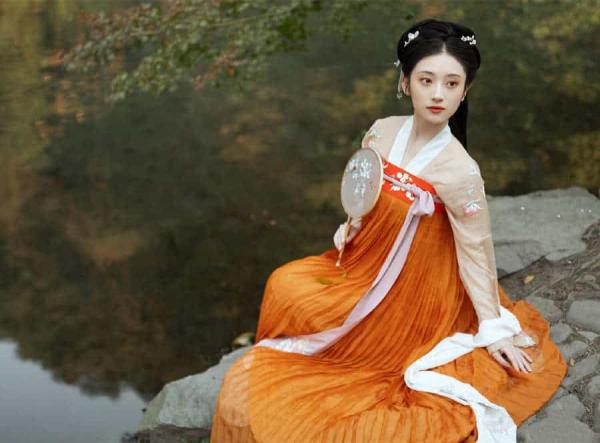
For men’s clothing in Tang Dynasty, the fashionable attire consisted of a head wrap and robe. Since the Tang Dynasty, a fixed ornament called a “headband” was added beneath the head wrap. Tang Dynasty officials primarily wore round-collared, narrow-sleeved robes, with an additional horizontal sash beneath the robe—a significant feature of men's clothing at the time. Beyond the round-collared, narrow-sleeved robe, ceremonial attire was worn for significant occasions like sacrificial rites. These ceremonial garments largely followed Sui Dynasty conventions: a ceremonial cap or cage-crown on the head, a front-opening, wide-sleeved robe, a skirt-like undergarment, and jade ornaments with sashes.
The Glory of Tang Dynasty: Accomplishments
The Improvement of the Political System
The "Three Departments and Six Ministries System" established in Tang Dynasty effectively decentralized power and strengthened central authority. The "Tang Code Commentary" was formulated, which is the most complete legal code in ancient China.
Economic prosperity
In agriculture, the Tang Empire implemented the “Equal Field System,” which ensured farmers' basic livelihoods through rational land distribution and boosted agricultural productivity. Handicrafts and commerce also flourished rapidly during this era, with cities like Chang'an and Luoyang becoming among the largest in the world at the time. The Tang Dynasty's economic prosperity was further reflected in the Silk Road—a vital trade corridor connecting East and West. It not only facilitated the exchange of goods such as silk, porcelain, and tea but also fostered the dissemination of culture and religion.
Artistic Brilliance
The artistic forms of the Tang Dynasty, such as poetry, painting, calligraphy, and music, reached unprecedented heights in Chinese history. Poets like Li Bai, Du Fu, and Wang Wei, with their outstanding talents, created numerous popular poems. The calligraphy art of the Tang Dynasty also made significant progress, with works by calligraphers like Yan Zhenqing and Liu Gongquan regarded as models by later generations. In terms of painting, Tang Dynasty's landscape paintings, figure paintings, etc., had various styles and exquisite techniques.
Military Strength
The military power of the Empire Tang was also among the best in the world at that time. During Emperor Taizong's reign, through a series of wars, the territory was expanded and a large empire was established. The Tang Dynasty set up institutions such as the Protectorate and the Military Governor in the border areas to ensure effective management of the border regions. Through military conquests, diplomatic means, and the "marriage alliance" policy (e.g. Princess Wencheng and Songtsen Gampo of Tibet), the Tang Dynasty successfully established good relations with neighboring countries, promoting cultural exchanges and economic interactions.
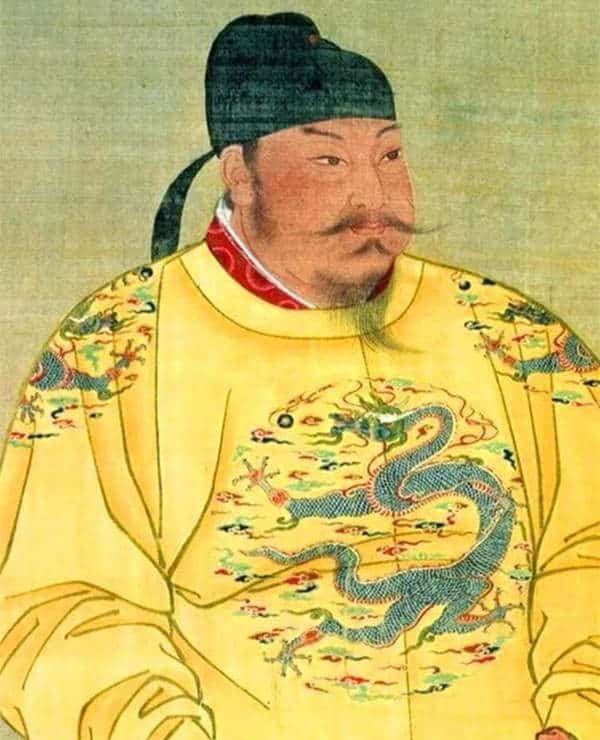
Technology Achievements
Block printing technology emerged in the early Tang Dynasty. In 868, it was used to print the "Diamond Sutra". Monk Yi Xing formulated the "Great Avatara Calendar" and completed the actual measurement of the Earth's meridian. Sun Simiao wrote "The Thousand Gold Prescriptions" (Classical Texts of Traditional Chinese Medicine). and during the reign of Emperor Gaozong of Tang, "The Imperial Pharmacopoeia of Tang" was compiled as the world's first national pharmacopoeia.
Architecture
Grand and imposing, the architecture of the Tang Dynasty marked the maturity of ancient Chinese architecture. The Daming Palace, the imperial palace of the Tang Dynasty, is some of the best examples. The largest and most complex wooden structure building constructed during the Tang Dynasty was the Mingtang, built by Wu Zetian in the fourth year of Chongyong (688 AD). The remaining Tang Dynasty wooden structures that are in relatively good condition include Foguang Temple, Tian Tai An, Guangren Wang Temple, and Nan Chan Temple in Shanxi Province.
Strange Tales of Tang Dynasty
Building upon the traditions of the Wei, Jin, and Southern and Northern Dynasties, the Tang Dynasty marked the golden age of Chinese supernatural fiction. Below is a renowned strange tale of Tang Dyansty.
The Tale of the Wandering Soul - Written by Chen Xuanyou
Zhang Qianniang and Wang Zhou were childhood sweethearts. Qianniang's father, Zhang Yao, had once promised her hand to Wang Zhou in marriage. Yet upon reaching adulthood, Zhang Yao instead betrothed Qianniang to another. Overcome with grief, Wang Zhou journeyed far to the capital, and Qianniang resolutely followed him. They lived together for five years and bore two sons.
As Qianniang longed for her parents, Wang Zhou brought his wife and sons back to Hengzhou to seek forgiveness from her family. Upon arriving home, Zhang's father found the situation deeply strange, for his daughter Qianniang had been confined to her chamber for years, never stepping outside the house. When the two Qianniangs met, their bodies merged into one, though their clothing remained layered. The truth was revealed: it had been Qianniang's spirit following her lover, not the real Qianniang.
